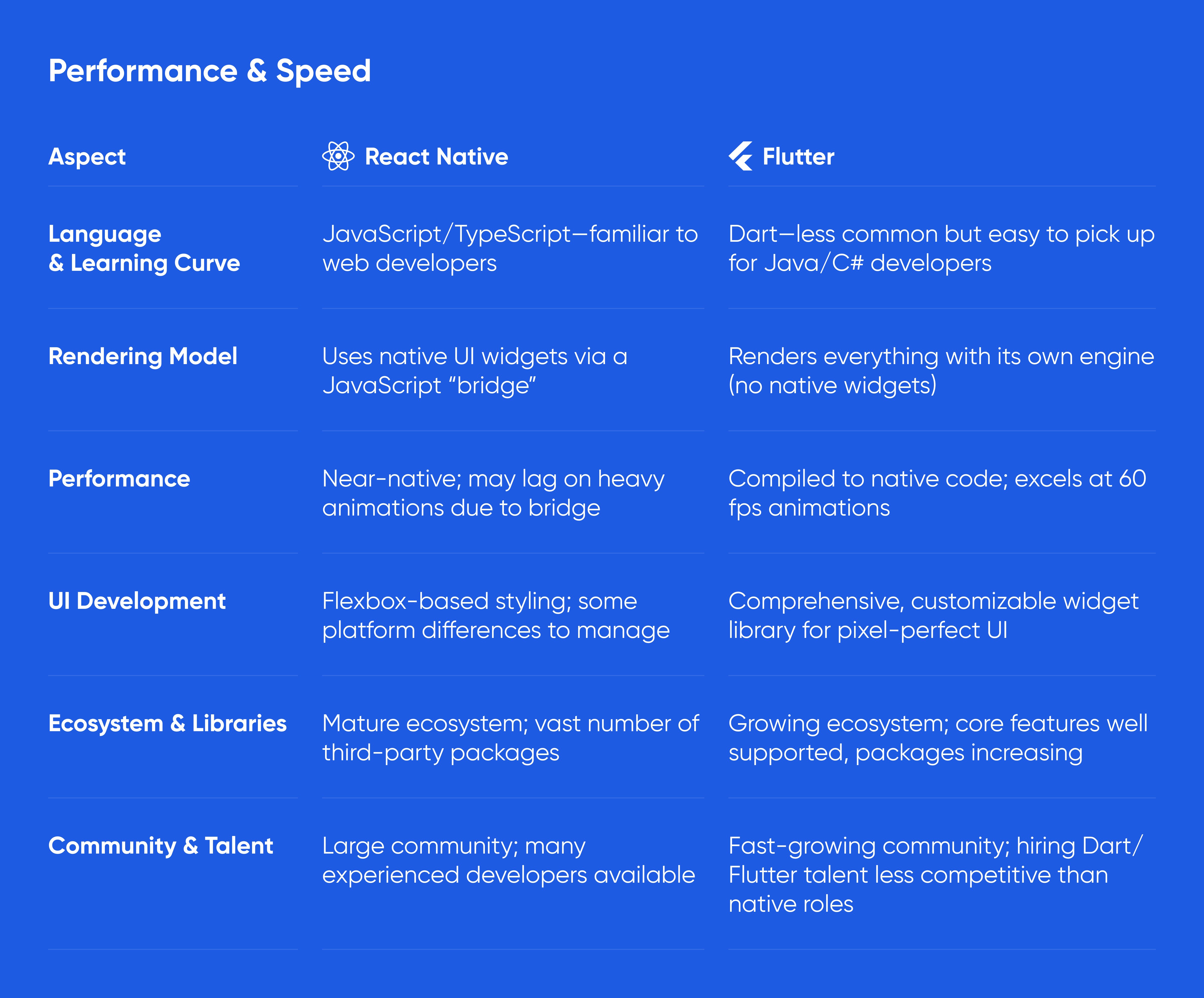Mobile apps are critical for startups—but building separate native apps for iOS and Android can double your development time and cost. Cross-platform frameworks tackle this challenge by letting you write one codebase that runs everywhere. Two leading options today are React Native and Flutter. Both promise faster time-to-market, but they take different approaches under the hood. This guide breaks down their strengths, trade-offs, and decision criteria so you can pick the right tool to launch and scale your app.
What Is React Native?
React Native is a JavaScript framework created by Facebook. It uses the popular React library and allows you to build mobile UIs with:
-
JavaScript (or TypeScript) and JSX syntax
-
Native components (buttons, lists, toggles) rendered by the device’s UI engine
-
Hot reloading, so code changes appear instantly in the simulator or device
Startups with web or React experience find React Native easy to adopt. Because it uses real native widgets, apps feel authentic to each platform. Major brands like Facebook, Instagram, and Airbnb have successfully shipped React Native experiences.
What Is Flutter?
Flutter is Google’s UI toolkit that compiles Dart code into native ARM executables. Key characteristics include:
-
Dart language, designed for fast apps and easy object-oriented programming
-
Custom rendering engine (Skia), which draws every pixel of your UI
-
Hot reload, enabling rapid iteration on designs and logic
-
Rich widget library, with Material Design and Cupertino-style components
By controlling every pixel, Flutter delivers ultra-smooth animations and consistent look-and-feel across platforms. Google Ads, Alibaba, and BMW are among the companies that trust Flutter’s performance and design flexibility.
Side-by-Side Comparison

Language & Learning Curve
-
React Native: If your team already builds React web apps, transitioning to mobile is straightforward. JavaScript’s ubiquity means there’s an abundant pool of developers.
-
Flutter: Dart may be new to your team. However, its syntax resembles Java or C#, and strong typing can reduce runtime errors, resulting in more robust codebases in the long run.
Performance & Rendering
-
React Native: Updates UI by communicating between JavaScript and native modules over a “bridge.” This works well for many use cases but can introduce latency for complex animations or large datasets.
-
Flutter: Compiles to native ARM code and handles rendering internally, delivering consistent 60 fps performance, even for intricate UIs.
UI Consistency & Customization
-
React Native: Relies on platform conventions. If you want a uniform look across iOS and Android, you’ll need to write additional styling logic.
-
Flutter: Every widget is rendered identically on both platforms. You get turnkey Material (Android) and Cupertino (iOS) widgets, but you can also build fully custom components with complete control.
Ecosystem Maturity
-
React Native: Battle-tested since 2015, with solutions for camera, maps, payments, and more. Third-party libraries cover nearly every need, though some may lag behind the latest React Native releases.
-
Flutter: Launched in 2017, Flutter’s ecosystem is rapidly expanding. The core team maintains official plugins for critical features (camera, geolocation, notifications), and community-driven packages fill in the rest.
Talent Availability
-
React Native: High demand but also high supply—JavaScript developers are plentiful.
-
Flutter: Growing demand and fewer schools teaching Dart, which currently makes hiring slightly more competitive. However, many developers enjoy learning Dart because of its clean design and performance benefits.
Real-World Startup Use Cases
-
React Native Success:
-
- Discord: Chose React Native to share code between desktop and mobile, speeding up feature parity.
-
Uber Eats: Applies React Native selectively for specific screens, benefiting from native performance coupled with cross-platform code sharing.
-
Flutter Success:
-
- Philips Hue: Built a unified app controlling smart lights across platforms with fluid animations.
-
Reflectly: A journaling app that leverages Flutter’s animations to create a delightful, consistent UX across devices.
How to Choose for Your Startup
- Assess Your Team’s Expertise:
If you have experienced React/JS developers, React Native accelerates ramp-up.
If you prioritize performance and pixel-perfect UI—and are willing to learn Dart—Flutter pays dividends.
- Define Your App’s Needs:
Heavy animations or custom animations? Lean Flutter.
Mostly standard UI patterns and rapid MVP launch? React Native might be faster.
- Consider Long-Term Vision:
Web and desktop targets? Flutter’s multi-platform reach is compelling.
Mobile-only, with tight integration to existing React web code? React Native may offer stronger synergy.
- Evaluate Community & Support:
Both have vibrant communities. Check whether critical plugins or integrations you need are stable and maintained.
Next Steps
-
Prototype Quickly: Build a small proof-of-concept in each framework to evaluate developer experience, performance, and tooling.
-
Run Performance Tests: Measure load times, memory usage, and animation smoothness on target devices.
-
Map Out Feature Roadmap: Identify any platform-specific or hardware-intensive features early to see how each framework handles them.
Choosing the right cross-platform framework shapes your product’s speed to market, user experience, and total cost of ownership. Both React Native and Flutter have powered hundreds of successful apps—but your unique team, timeline, and feature requirements will guide the optimal path.
Ready to get your mobile app off the ground? Movadex’s mobile experts are proficient in both React Native and Flutter. We’ll evaluate your needs, build rapid prototypes, and deliver a production-ready app that delights users—and accelerates your startup’s growth. Contact us today.




